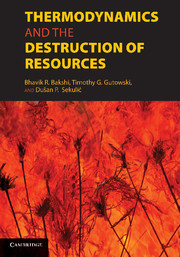Book contents
- Frontmatter
- Contents
- Contributor List
- Foreword by Herman E. Daly
- Foreword by Jan Szargut
- Preface
- Introduction
- PART I FOUNDATIONS
- PART II PRODUCTS AND PROCESSES
- PART III LIFE-CYCLE ASSESSMENTS AND METRICS
- PART IV ECONOMIC SYSTEMS, SOCIAL SYSTEMS, INDUSTRIAL SYSTEMS, AND ECOSYSTEMS
- 14 Early Development of Input–Output Analysis of Energy and Ecologic Systems
- 15 Exergoeconomics and Exergoenvironmental Analysis
- 16 Entropy, Economics, and Policy
- 17 Integration and Segregation in a Population – a Thermodynamicist's View
- 18 Exergy Use in Ecosystem Analysis: Background and Challenges
- 19 Thoughts on the Application of Thermodynamics to the Development of Sustainability Science
- Appendix: Standard Chemical Exergy
- Index
- References
18 - Exergy Use in Ecosystem Analysis: Background and Challenges
Published online by Cambridge University Press: 01 June 2011
- Frontmatter
- Contents
- Contributor List
- Foreword by Herman E. Daly
- Foreword by Jan Szargut
- Preface
- Introduction
- PART I FOUNDATIONS
- PART II PRODUCTS AND PROCESSES
- PART III LIFE-CYCLE ASSESSMENTS AND METRICS
- PART IV ECONOMIC SYSTEMS, SOCIAL SYSTEMS, INDUSTRIAL SYSTEMS, AND ECOSYSTEMS
- 14 Early Development of Input–Output Analysis of Energy and Ecologic Systems
- 15 Exergoeconomics and Exergoenvironmental Analysis
- 16 Entropy, Economics, and Policy
- 17 Integration and Segregation in a Population – a Thermodynamicist's View
- 18 Exergy Use in Ecosystem Analysis: Background and Challenges
- 19 Thoughts on the Application of Thermodynamics to the Development of Sustainability Science
- Appendix: Standard Chemical Exergy
- Index
- References
Summary
Introduction to Ecological Thermodynamics
Ecology covers many spatial, temporal, and organizational scales, from individual to population, communities to ecosystems. At the broadest scale, ecosystem ecology is mostly concerned with how energy and matter enter, circulate, and are discharged through a biotic and abiotic open-system complex. This aggregate approach often overlooks and obscures the minute details of how individual organisms grow, reproduce, and respond within their environment. Therefore, there exists a divide between evolutionary ecology, dealing with the internal, reductionistic, genetic workings of individuals, and ecosystem ecology at the holistic, integrative scale. Attempts have been made to span this chasm by specifically relating the way large-scale ecosystem processes develop alongside evolutionary processes (e.g., see [1–4]).
As open and far-from-equilibrium systems, all ecosystems are dependent on a continual input of exergy, defined, as in Chap. 1, as energy available to perform work, in order to maintain their complex and adaptive functionality. At the same time, ecosystems need to discharge into the surrounding both matter and energy in degraded forms to keep the matter and energy balance. Even though the concept of exergy was introduced in 1953, this need was recognized much earlier and expressed in the framework of classical thermodynamics (CT) as the necessity of acquiring free energy. This is an evolutionary challenge according to Lotka [5], who stated that those organisms, and the systems in which they exist, which are better equipped to capture and utilize this energy, should have an evolutionary advantage over ones that are less capable of doing so.
- Type
- Chapter
- Information
- Thermodynamics and the Destruction of Resources , pp. 453 - 476Publisher: Cambridge University PressPrint publication year: 2011
References
- 1
- Cited by

